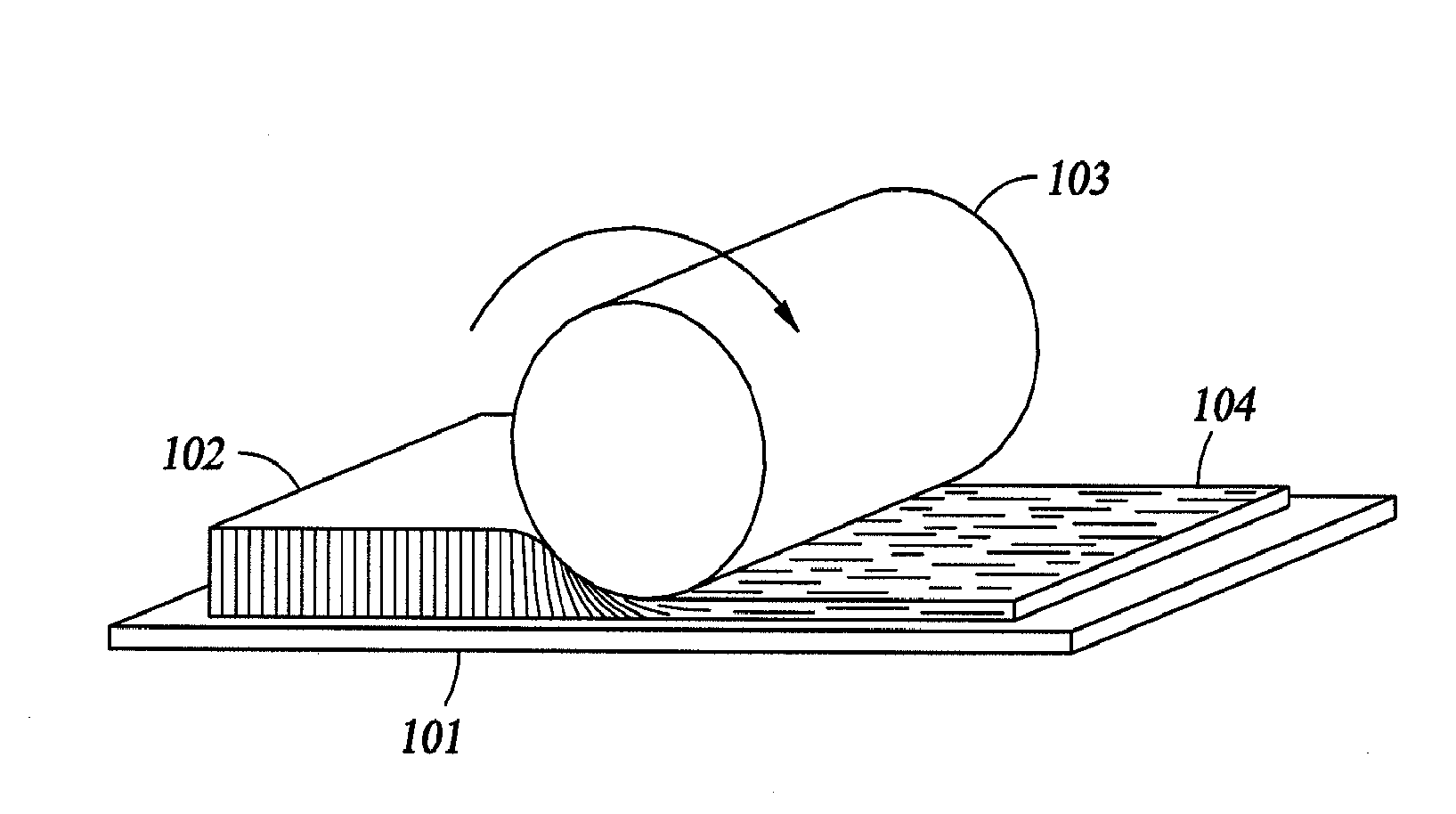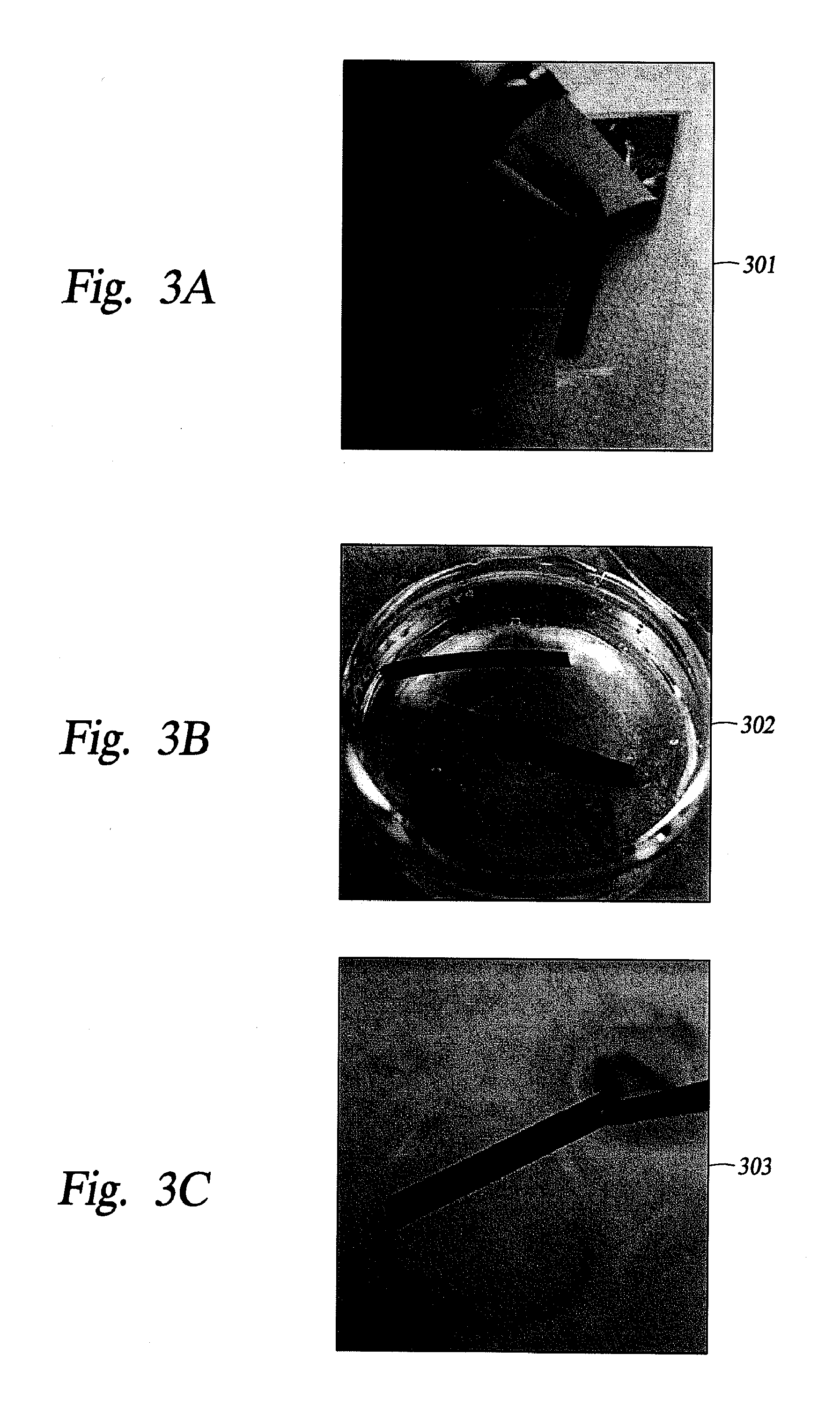Method for Producing Aligned Near Full Density Pure Carbon Nanotube Sheets, Ribbons, and Films From Aligned Arrays of as Grown Carbon Nanotube Carpets/Forests and Direct Transfer to Metal and Polymer Surfaces
- Summary
- Abstract
- Description
- Claims
- Application Information
AI Technical Summary
Problems solved by technology
Method used
Image
Examples
example 1
Measurement of the Compression Factor of Carbon Nanotube Films
Measurement of the degree to which the rolling process compresses the carbon nanotube array was studied with a carbon nanotube array grown in a 25 torr atmosphere comprising C2H2, H2O, and H2. Growth of the carbon nanotube array to an average of about 613.6 μm tall was achieved in 30 minutes under these growth conditions. After the compressing step, the resulting carbon nanotube film was partially peeled from the substrate in order to measure its thickness. SEM images of the carbon nanotube array before and after compressing are shown in FIG. 2. SEM measurements indicated an average carbon nanotube film thickness in this representative embodiment of about 30.32 μm, which represents over a 20-fold compression of the initial carbon nanotube array. The measured density of the uncompressed carbon nanotube array shown in SEM image 201 is about 20.6 mg / cm3, which gives a density of about 416 mg / cm3 after 20-fold compression. Th...
example 2
Alignment of Carbon Nanotube Films not Heated with an Etchant
Polarized Raman spectroscopy was utilized to verify retention of carbon nanotube alignment in the film following the compressing step. Polarized Raman spectra for a representative single-wall carbon nanotube array and single-wall carbon nanotube film formed by compressing the array are shown in FIG. 9. In spectrum 901, a 633 nm laser spot was focused on the side of the carbon nanotube array, with the laser light polarization both parallel (0°) and perpendicular (90°) to the direction of carbon nanotube alignment. The absorption of laser light by a single-wall carbon nanotube array decreases as the angle between the laser light polarization and the single-wall carbon nanotube axis approaches 90° . As such, this method provides an estimation of the overall alignment of the single-wall carbon nanotubes comprising the array. As shown in polarized Raman spectrum 901, the ratio between the intensity of the G-band in the parallel...
example 3
Comparison of Single-Wall Carbon Nanotube Arrays not Heated in an Etchant and Single-Wall Carbon Nanotube Arrays Heated in an Etchant
Physical comparison of the two methods for carbon nanotube film removal was performed. In the wet process, the catalyst is etched away from the growth surface by acid to release the carbon nanotube film. In the dry process, heat treatment with a gaseous etchant provides eventual release of the film after the compressing step. First, a comparison of carbon nanotube arrays either treated with an etchant or not treated with an etchant were studied. In order to study the effect of catalyst-film interactions, two identical single-wall carbon nanotube arrays were produced under the growth conditions (2 mins, 750° C.), except that one of them was heated in a gaseous mixture comprising H2O for 1 minute following growth. The other one was rapidly cooled and removed from the reactor. Following growth, a droplet of water was placed on the top of each single-wall ...
PUM
| Property | Measurement | Unit |
|---|---|---|
| Density | aaaaa | aaaaa |
| Metallic bond | aaaaa | aaaaa |
Abstract
Description
Claims
Application Information
 Login to View More
Login to View More - R&D
- Intellectual Property
- Life Sciences
- Materials
- Tech Scout
- Unparalleled Data Quality
- Higher Quality Content
- 60% Fewer Hallucinations
Browse by: Latest US Patents, China's latest patents, Technical Efficacy Thesaurus, Application Domain, Technology Topic, Popular Technical Reports.
© 2025 PatSnap. All rights reserved.Legal|Privacy policy|Modern Slavery Act Transparency Statement|Sitemap|About US| Contact US: help@patsnap.com



